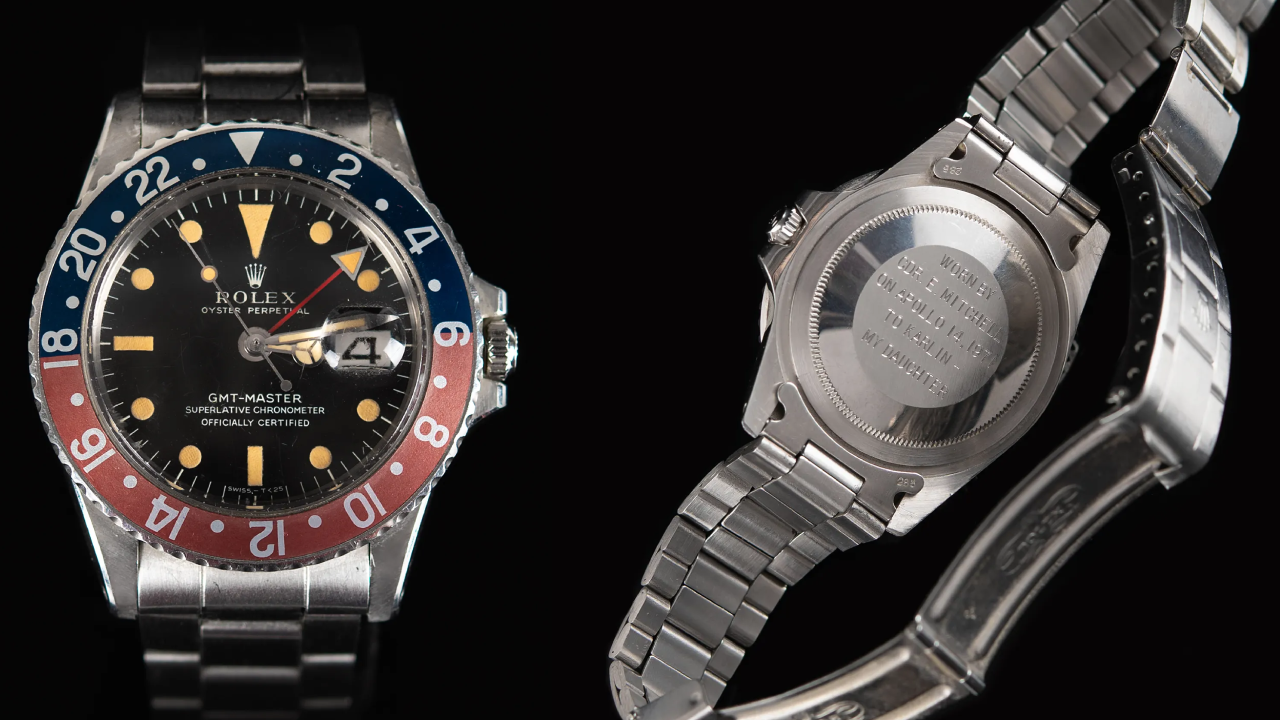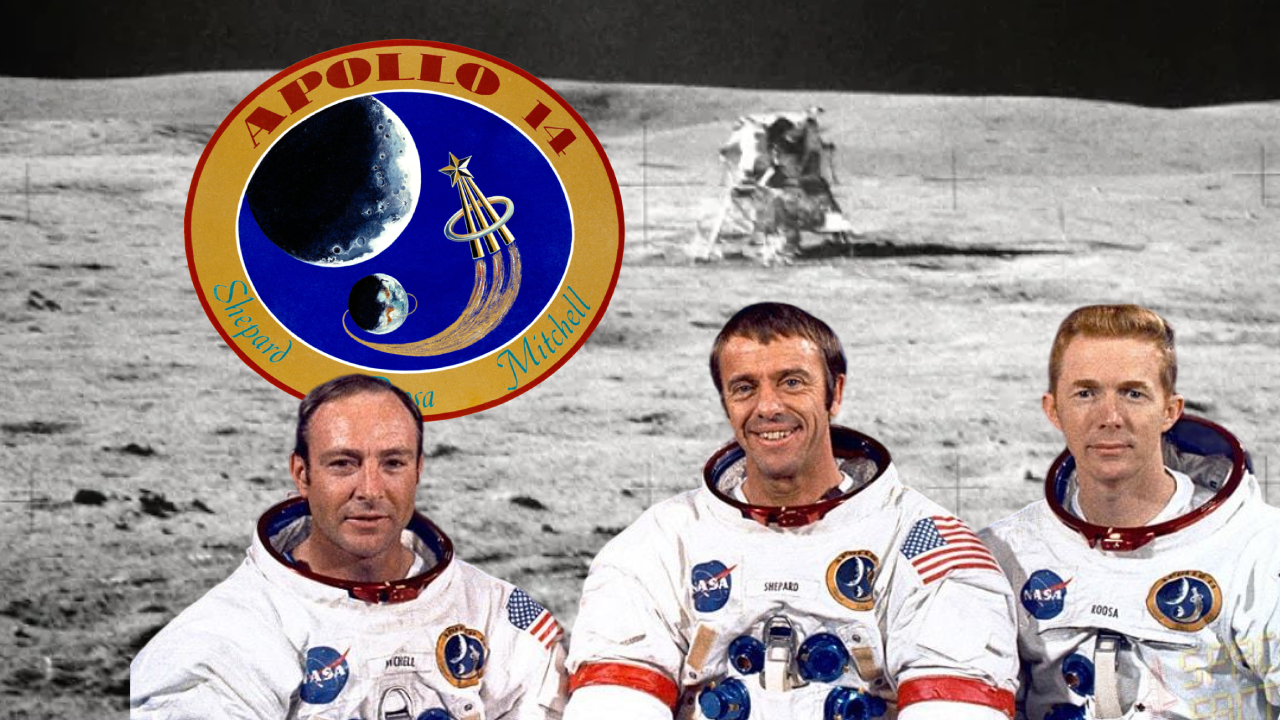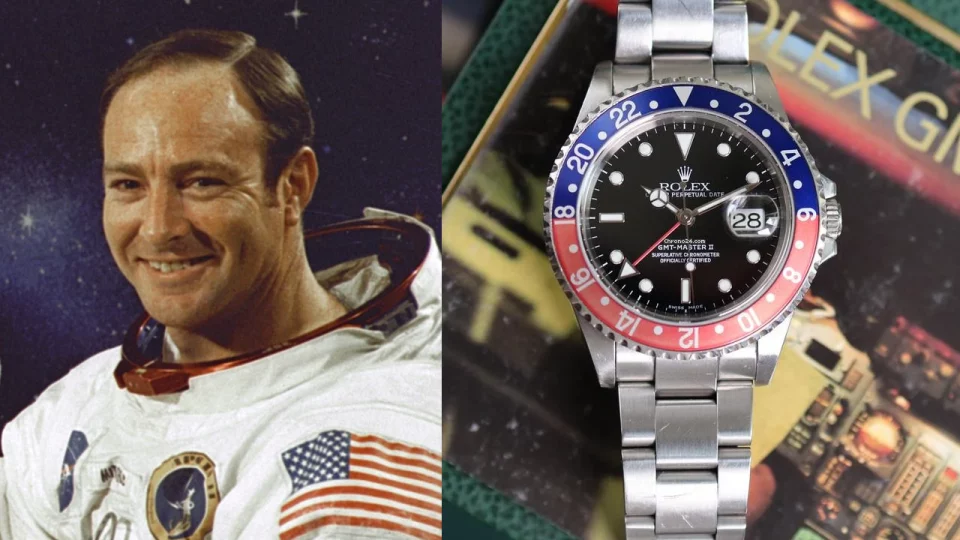When we think about space exploration and watches, it’s almost automatic to associate the Omega Speedmaster with the Moon. After all, the Speedmaster is the famous “Moonwatch,” officially selected by NASA for the Apollo missions. However, there was another timepiece that left its mark on lunar history: a Rolex GMT-Master ref. 1675, worn by astronaut Edgar Mitchell during the Apollo 14 mission. This iconic watch is now up for auction, and it comes with a unique backstory that could shake the horological world.
Table of Contents
A Historic Timepiece with Lunar Provenance
On February 5, 1971, Edgar Mitchell stepped onto the Moon, becoming the sixth person to walk its surface. During his time exploring the Moon as part of the Apollo 14 mission, Mitchell had a Rolex GMT-Master ref. 1675 strapped to his right wrist, making it the first Rolex to be worn on the lunar surface. Known for its red-and-blue “Pepsi” bezel, this watch was not only the first Rolex on the Moon but also the first automatic watch to make the journey.
The Rolex GMT-Master model was originally designed in the early 1950s for Pan American World Airways pilots, who needed a watch capable of tracking multiple time zones. By the time Mitchell took it to the Moon, the GMT-Master had already become an icon, symbolizing precision, adventure, and reliability. Its appearance on the Moon cemented its place in horological history, challenging the dominance of the Omega Speedmaster as the quintessential “space watch.”
While there are no photographs of Mitchell wearing the watch on the Moon itself—due to the bulky space suit and the challenges of taking photos in such an environment—there are several documented images of Mitchell wearing the GMT-Master before and after the mission. These photos provide compelling evidence of the watch’s incredible journey, from Earth to the Moon and back again.

The Journey of the Apollo 14 GMT-Master
Mitchell’s Rolex GMT-Master ref. 1675 was a standard model, featuring the distinctive red-and-blue Pepsi bezel that enthusiasts love. It had an automatic Chronometer-certified movement, which was a testament to Rolex’s precision engineering. The watch’s hands and hour markers were treated with tritium lume, which had developed a beautiful patina over the years. Its steel Oyster bracelet, with a folded-link construction, added a rugged yet elegant look to the timepiece.
One of the most sentimental aspects of this particular GMT-Master is its personalized inscription on the case back. Engraved with the words: “WORN BY CDR. E. MITCHELL ON APOLLO 14, 1971, TO KARLIN—MY DAUGHTER,” the inscription highlights the emotional connection between Mitchell and his daughter. This personal touch adds a profound layer to the watch’s already rich history, making it more than just a tool of exploration—it’s also a symbol of love and legacy.
This Rolex GMT-Master is not the only watch with NASA provenance. Other astronauts, such as Jack Swigert (Apollo 13), Stuart Roosa (Apollo 14), and Ron Evans (Apollo 17), also wore GMT-Masters on their respective missions. However, Mitchell’s watch holds a unique position as one of only two confirmed GMT-Masters to have been on the lunar surface. The other was worn by Ron Evans, and that watch was auctioned in 2009 for $131,450, eventually finding its way back to Rolex’s collection.
Rolex in Space: A Rival to the Omega Speedmaster
For decades, the Omega Speedmaster has been synonymous with space travel. It earned NASA’s approval through rigorous testing, surviving extreme temperatures, shock, and vibrations. The Speedmaster was the official watch of all manned Apollo missions and was famously worn by astronauts such as Buzz Aldrin and Neil Armstrong during the first Moon landing in 1969. It’s no wonder that the Speedmaster has become iconic in its own right, earning the nickname “Moonwatch.”
However, the story of Mitchell’s GMT-Master challenges the notion that Omega was the only watch to make history on the Moon. While Omega was the official sponsor of the Apollo missions, astronauts were not strictly limited to wearing only Omega watches. Personal watches were often brought along as backup timepieces or for sentimental reasons. Mitchell’s decision to bring his Rolex GMT-Master was a testament to the brand’s reliability, even in the harshest environments.
The Rolex GMT-Master wasn’t officially endorsed by NASA, nor was it specifically designed for space missions, but its performance during Apollo 14 showed that it was capable of withstanding the demanding conditions of space exploration. The mere presence of the GMT-Master on the lunar surface speaks volumes about Rolex’s engineering and its appeal to those seeking adventure and reliability.
The Auction: A Rare Opportunity for Collectors
The excitement surrounding the upcoming auction of Mitchell’s Rolex GMT-Master is palpable. The watch is being sold at RR Auctions, and as of the time of writing, bidding has reached $22,000. This price is expected to climb significantly as the auction progresses, potentially reaching a final price of around $400,000. Collectors and enthusiasts around the world are eager for the chance to own a piece of lunar history, especially given the watch’s confirmed Moon provenance and the letter of authenticity signed by Mitchell himself.
The letter reads: “The accompanying Rolex watch was worn by me during the Apollo 14 mission,” providing undeniable proof of the watch’s significance. For collectors, having a watch that has been to the Moon is the ultimate prize—something that goes beyond horological value and enters the realm of cultural history.
Rolex itself might be interested in acquiring this watch, just as it did with the GMT-Master worn by Ron Evans in 2009. For Rolex, having these timepieces in their collection is not only a testament to the brand’s heritage but also a reminder of their contribution to exploration and human achievement. Watches like these are more than just instruments for telling time—they are symbols of humanity’s pursuit of the unknown and the courage of those who dare to venture into space.

The Legacy of Edgar Mitchell and the Apollo Missions
Edgar Mitchell was one of the most remarkable astronauts of his time. As a member of the Apollo 14 crew, he spent nine hours walking on the lunar surface, conducting scientific experiments, and collecting rock samples. Mitchell’s journey was about more than just exploration—it was a mission to expand humanity’s understanding of the cosmos. He was a strong advocate for space research and believed deeply in the importance of continuing the legacy of the Apollo program.
The Rolex GMT-Master that accompanied Mitchell to the Moon is an enduring reminder of his achievements and contributions. Watches worn by astronauts hold a special place in the world of horology because they are linked to some of humanity’s greatest accomplishments. In the case of Mitchell’s GMT-Master, it represents not only the success of Apollo 14 but also the spirit of adventure and the quest for knowledge that defined the Apollo era.
The fact that Mitchell wore a Rolex at an official Omega-sponsored event also highlights the individuality and freedom that astronauts had when it came to personal items. It’s a reminder that, even during highly regulated missions, the astronauts were individuals with personal preferences, willing to take along items that held significance to them.
